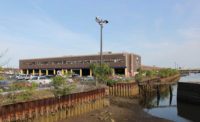Bigger isn’t always better when it comes to sustainable infrastructure. A new report assessing a proposed sea barrier in Boston Harbor estimates the structure could cost more than $11 billion. The city-commissioned study also found that investing in smaller, shore-based resilience projects is more feasible and effective than a megaproject that could take 30 years to permit and construct.
Released by the University of Massachusetts Boston Sustainable Solutions Lab on May 29, the report says Boston could sustain billions of dollars of storm-related damage by the time the wall would be completed. It says the city should focus on projects outlined in the recent Climate Ready Boston initiative, including an up to $3-million effort to elevate streets in Charlestown and a $100,000 deployable flood barrier on East Boston’s Greenway.
Paul Kirshen, academic director of the Sustainable Solutions Lab, is the study’s lead author. He says in a statement that while harbor barrier systems have helped other coastal cities, a Boston Harbor sea barrier would have “limited benefits compared to the alternative.” Kirshen says focusing on neighborhood projects is a “more impactful strategy” because that can more easily “maximize investment and benefit everyone.” Local projects also have the flexibility to “adjust to the uncertainties of climate change,” he says.
The report, which says the barrier could be revisited as climate science evolves, studied construction costs and environmental impacts of two barrier concepts, including a 3.8-mile outer harbor wall from Winthrop to Hull that would be the largest in the world. An inner harbor wall from Logan Airport to the Seaport District could cost as much as $8 billion.
Opponents say the project could replicate the cost overruns of Boston’s 1990s money pit, the Big Dig. The Central Artery/Tunnel was sold as an $8-billion project but came in at more than $14.6 billion. The seawall’s price tag, however, could be offset by public-private partnerships to build solar, wind, and tidal power on the barrier, says Blake Jackson, Stantec’s Boston-based sustainability design leader. Incorporating rail or bus rapid transit could also help alleviate traffic congestion, he adds.
“While a large-scale solution like a harbor barrier would require significant investment,” Jackson wrote in an email, “it would also deliver sweeping protection as opposed to a building by building/parcel by parcel approach.”
Jackson says that land-based solutions should still be used to mitigate other climate-change impacts, such as increased precipitation and temperatures.
Daniel Stapleton, senior vice president and senior principal at GZA, was one of several industry members to peer review the sea barrier report. He says the barrier would not manage tidal or nuisance flooding but would mostly “prevent extreme flood events.”
A barrier would be expensive to maintain. The report found that a gated barrier would be needed to minimize negative impacts to the city’s maritime activity. The gates would only close during storm surges. But with more frequent flooding events projected in the years to come, opening and closing the gates as often as 50 times a year would lead to frequent mechanical failures, researchers noted.
Boston is projected to see 9 in. of sea-level rise by 2030 and 36 in. by 2070. Four consecutive nor’easters pummeled the region in March alone, creating ocean storm surges of nearly 4 ft and causing significant coastal flooding.
Arcadis managed three components of the study, including evaluating the barrier's engineering feasibility, its constructibility and a cost-benefit analysis of the the expected economic impacts due to coastal flooding with and without the barrier alternatives in place. Hugh Roberts, area leader for Arcadis' water business, says the analysis found that shore-based coastal protection is the best strategy. Roberts says the "we found that a harbor-wide barrier system is not an effective coastal risk reduction strategy for a number of reasons, including being technically impractical, less effective, and cost prohibitive versus continued investment in shore-based coastal protection solutions.”
In April, the University of Massachusetts Boston released a report that calculated the cost of neighborhood projects necessary to combat climate change at $2.4 billion. The report also outlined financing strategies, which included a state carbon tax and increased state gas tax.
The city should move on some of those recommendations “quickly,” says Lydia Edwards, a Boston city councilor whose district covers more coastline than any other. “Rather than investing billions into a harbor barrier that may never work,” she says, “we should deploy resources into green infrastructure, better buildings, stormwater management and local, green, resilient energy systems.”





